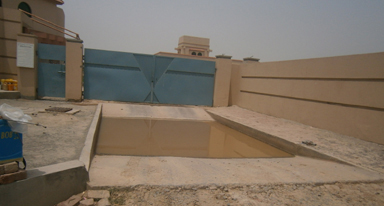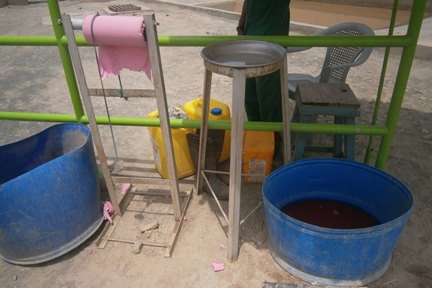|
The easy and
quick method of cleaning animal house is with liberal use of
tap water, proper lifting and disposal of all dung and used straw
bedding, and providing drainage for complete removal of liquid waste
and urine. The daily removal of
feed and fodder left over in the manger reduces the fly
nuisance. Following points should be kept in mind regarding
sanitation and hygiene of animal house:


-
Spread
Calcium carbonate at the entrance of shed area to disinfect the
shoes of staff.
-
Entry of
workers of other farms should be avoided.
-
Dry
dusting/sweeping is not recommended; dust will stay hanging in
air and later on settle down. So moisten the area then sweep.
-
Remove dung
and used bedding completely.
Construct
manure pit for proper handling of manure.
-
Avoid spilling of dung and used bedding while carrying it out.
-
Avoid the use of dirty water in cleaning the sheds.
-
Never put the fresh fodder over the previous day’s left over
fodder in the manger/feeding table.
-
Prevent algae to grow in the water troughs.
-
Use proper
concentration of
disinfectant/insecticide solutions to avoid any toxic
poisoning.
-
All
mechanical instruments as feeding hoppers, drinkers, milking
machines, ventilation, fans, heating and lighting equipments,
and
fire extinguishers should be in working conditions and inspected
regularly.
-
Electric
appliances should not be approached by the animals.
-
If any
abnormality in udder or teat then must identify and treat the
situation.
-
Construct
hoof dip filled with
CuSO4 on the way from dairy shed to milking
shed for the hoof care.
Quarantine
Measures
We must have to
observe quarantine to observe hygiene:
-
Keep sick
animals separate for at least three weeks and then mixed into shed
-
Do not
exchange breeding stocks with other farms
-
Avoid stray
dogs as they play important role in disease spreading
-
Keep the
environment healthy by using disinfectants and antiseptics
Ticks Control Program
Ticks are
economically important in cattle and livestock species. These are
vectors for parasites like babeisia, theileria, anaplasma,
virus like in case of Crimean Congo Fever; bacteria
like pasterurella, brucella, listeria, staphylococcus. Ticks are
also blood suckers. Ticks belonging to genus Ixodes and Ornithodorus
are associated with tick paralysis because of toxin is released from
ticks. Important species of ticks are Boophilus, Hyaoloma,
Rhipicephalous, Amblyomma. Ticks show a variety of host contact
pattern during their life cycle. One host tick: Boophilus, each
developmental stage feeds upon same host. Three host species:
Hyalomma, complete different larval stages on different hosts.
Control
Strategies:
-
Housing of
animals in tick proof buildings. Cracks and crevices are big
source of ticks. For this purpose caulking of wall and roof
should be
done.
-
Herbage and
wastage of farm (dung) should be burned slowly as ticks are killed
by smoke.
-
Manual
removal of ticks. But do not twist it in hand because it causes
Crimean Cango Hemorrhagic Fever in humans. Always remove ticks
with forceps in anti-clock wise direction.
-
Clearance of
vegetation.
-
Use of
Acaricides, in the form of dip, injection, pour on, ear
tags etc.
-
Tick vaccines
are available but not in Pakistan.
-
Development
of resistant tick breeds. Sahiwal cattle is resistant to ticks
due to some factors like its skin moves, hairs are short, and
straight and secretion from skin (sebaceous).
-
Biological
Control: Predators including birds, rodents, screws, ants and
spiders may play a role in tick control in some areas.
-
Ethnoveterinary Practices
- Salt
is applied on body of animal. Taramira oil mixed in simple oil
can be applied on body. 250 mg of terpentine is soaked in water
and next morning mixed with ice or cold water and 100 g salt is
added and applied to animals.
-
Dipping is an
expensive operation but is desirable for tick eradication
program. The construction of a dipping tank varies according to
the kind and number of animals required to be dipped. In
tropical and subtropical countries it is preferable to cover the
tank with a roof, as it will avoid excessive concentration of
the insecticides by evaporation or dilution by rain. The
following precautions should be observed while dipping animals
for tick control and treatment:
▪
Wounds must
be attended to thoroughly before resorting to dipping otherwise
dipping makes the
animal feel more discomfort and toxicity may
occur
▪
Avoid dipping
on a cloudy, rainy, windy or cold day
▪
The animals
to be dipped should not be thirsty
▪
Animals that
are fatigued due to any reason should not be dipped
▪
Avoid
contamination of the dipping tank with
organic matter as it lowers the concentration of
insecticides
in the dip
▪
The animals
must actually swim in the tank and have one or two dips of their
heads in the bath. For
this purpose, two attendants with forked
blunt sticks should direct the operation
▪
Let the
animals drain properly before they are sent out to the fields
otherwise the insecticide will
cause pollution of feed, fodder
or other things coming in contact with insecticides. Design the
dipping
area with a good drain back to the dipping tank.
▪
The
concentration of dip solution should be very carefully adjusted according
to manufacturer’s
instructions
▪
Weak animals
less than three months old, lactating animals or animals
in advanced pregnancy should
not be subjected to this operation
▪
While
handling any acaricide, avoid repeated or prolonged contacts
with skin and inhalation of dust
and mist. Wear clean clothing
and wash hands and face before eating or smoking after dipping
operation. Keep the
antidote ready for use in the case of any acaricide
poisoning
▪
Recommended
drug withdrawal period should be observed
▪
The dimension
of the dipping tank should be decided according the numbers and
type of dairy animals
on farm. The following dimensions for the
cattle farms are advisable:
◊ Maximum depth
– 3.5 meters, it includes 0.6-0.8 metre for splash walls
◊ Length – 16
meters, let at least middle half of it remain filled with 2.5 to
2.8 metres
deep insecticide, with entrance and exit having
convenient slopes.
◊ Width – 3.2
metres throughout the entire length
▪
Dipping tank
should have a cemented, impervious, non-slippery internal
lining. The entrance and exit
should have convenient slopes. It
should be filled in such a way that the animals are in a
position to
swim 4 to 5 metres on their way.

|

![]()



